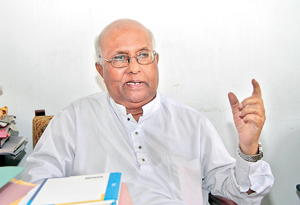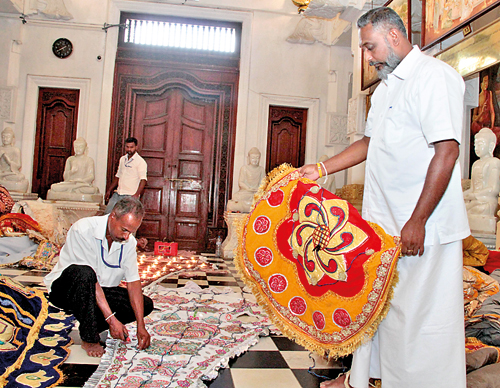Dressing up the favoured ones

Designing with a vision: Kishinchand Thadhani in his Asgiriya workshop and (inset) explaining how it all came about. Pix by Indika Handuwala
Two magnificent bull elephants chomp kitul trunks in torpid indulgence in the afternoon near Kandy Lake, lazily enjoying this natural state, ears flapping, till the dusk brings mahouts to tog them up. They are Miyan-Raja and Buruma-Raja, gifts from Myanmar to the Kandy Dalada Maligawa. Two perfect storybook specimens- with the much valued, dotted fading of skin pigment (gomara) and the classic contours epitomized in wood carvings in the Kandyan kingdom- at medieval Embekke, for example, they are much awaited at the Kandy Esala perahera, the country’s most historic pageant.
The Maligawa is a finicky employer when it comes to the perahera elephants- having strict, ancient rules of physiognomy- and pick only the classically most handsome. Miyan-Raja and Buruma-Raja, with crisscrossed tusks, are aristocratic enough in mien to flank the Magul Etha- the doyen of elephants in the Kandy Esala perahera- occupying the central position of carrying the Sacred Tooth Relic casket- towering at 11 feet.
We were on our way to meet Kishinchand Thadhani, who can claim to have ‘invented’ the modern elephant’s ceremonial garb- or the ‘caparison’- an odd medieval word conjuring up jousting horses in flowery coats.
Kishinchand Thadhani was but a boy when, watching the perahera majestically wending past through his father’s shop window, he was struck by the drabness of the elephant outfits. Though the cynosure of all eyes, the elephants’ costume seemed sad compared to the brilliant plumage of dancer, drummer or feudal aristocrat.
Only the neththimalaya (the part decorating the trunk) had brass decorations. The vast cloth covering the body was more or less a bed sheet. This spurred young Thadhani, and when he took over his father’s garment factory, he chose pachyderm clients over human ones.
He was the first to stitch the glitter of sequins into the costume, and came up with a coat-like design which needed no tying. The previous caparison had to be laboriously tied over the elephant with rope- with a whole rigmarole called ‘ren gahanawa’.
The easy fit-on outfit comes in three parts- the neththimalaya over the trunk, the two kan pethi or the ear covers and the large spread pita-wesma thrown over the back.

K. Meegahakumbura
The upstairs of the Thadhanis’ small bungalow in Asgiriya is the atelier. Sprawled on the working surface is the caparison for a Pattini devale elephant. The central motif on the amber velvet is a pink Tibetan lotus- made up of tiny sequins that look like glittering pomegranate seeds. Around each lotus: a border of annasi-mal (pineapple flower motifs) in peacock colours, and pointy bo-leaves in royal purple and argent.
The sequins are sewn not glued- requiring the fastidious finesse of many seamstresses. Thadhani employs a team of around 50, who are put into groups of eight. Each team takes around two months for a single caparison.
For the villager, who worships the chief elephant with fervour, the perahera pachyderms are the most fortunate of beasts, occupying a place often higher than humans. But in order to radiate regal splendour, the animal has to endure heavy padding- which could be stifling in tropical nights with blazing torches alongside. There is a pillow between two layers of cloth, and above it Mr. Thadhani’s caparison- which itself has four layers: a lining of rough cloth, a lining of softer cloth, foam rubber and finally the velvet over it all.
At the Dalada Maligawa where we go to find the history of elephant dressing, we meet K. Meegahakumbura who has his office in the recesses of the Maligawa’s rambling complex of ancient and modern (all seamlessly chipped together- medieval stone running into new cement). The archives of the Sacred Tooth Relic are all in his memory and the distant drumming of a city throbbing with perahera fervour seems to invoke a deep pride of tradition in him.
Caparisoning elephants, he says, began in ancient India. Bodhi Varnana which were composed in celebration of the sacred Bo tree being brought to the island from India, describe decorated elephants in the processions. War-elephants also were decorated- though minimally- mostly with neththimalaya only.

At the Maligawa: Getting ready for the night’s perahera
What used to be vibrant North Indian designs have now mellowed into more Kandyan motifs. Apart from the lotus, there is the hansa-poottuwa- stylized swans wrapped elegantly around each other- beak on beak- or the many mythical creepers and flowers that flourish creating a classic poetry of unfurling scrolls.
They reflect something of modern Kandy- a mix of Dravidian vibrancy and tinsel over the white washed, plain wooden, stocky-solid architecture with stylized carving.
The old Maligawa caparisons share a musty underground room, rolled up in great bundles- whose custodian is old Mitraratne, in Maligawa livery, who has to send them to lesser peraheras across the country.
Mr. Thadhani is not the only outfitter to the Maligawa, though he is something of a trail-blazer. Statuesque and amiable with a blithe guffaw, this North Indian whose father came over from modern-day Pakistan has over the years created a thousand caparisons, but also other sequined tapestries- such as portraits of Kandy’s pantheon of deities- a hotch potch of Hindu, Buddhist and ancient aboriginal beliefs. He supplies all the main peraheras in the island- Kataragama, Mahiyangane, Muthiyangane, Bellanwila and Matara among many others.
His caparisons range in price from Rs. 65,000 to Rs. 1, 75,000.
Now 81, Thadhani has neither progeny nor protégé to whom he can pass on his craft. He quietly breaks down as he thinks of an art, practised for over 50 years with devotion, being lost. “God will send someone,” he says, wiping his eyes and looking up hopefully.
For it has been a spiritual calling for him to adorn the perahera elephants, and sheer gratification to see his life’s work shimmer in the limelight for all the world to see.
There is a sense of having come full circle- in that a North Indian is the doyen of caparison makers in the island today. It is also reflective of the Kandyan feudal tradition that this Indian, like the Rajasinhas – the last Nayak kings from Malabar, is an ardent Buddhist- a devotee of the Sacred Tooth Relic and great friend of the Mahanayakes.
The final Randoli perahera will be held on August 14.


